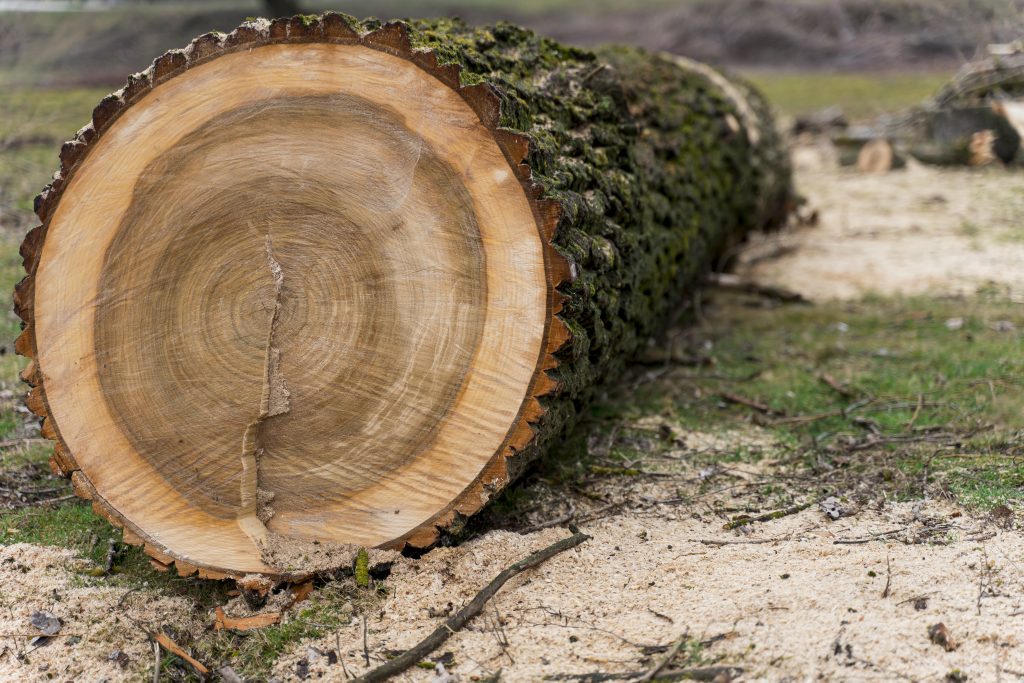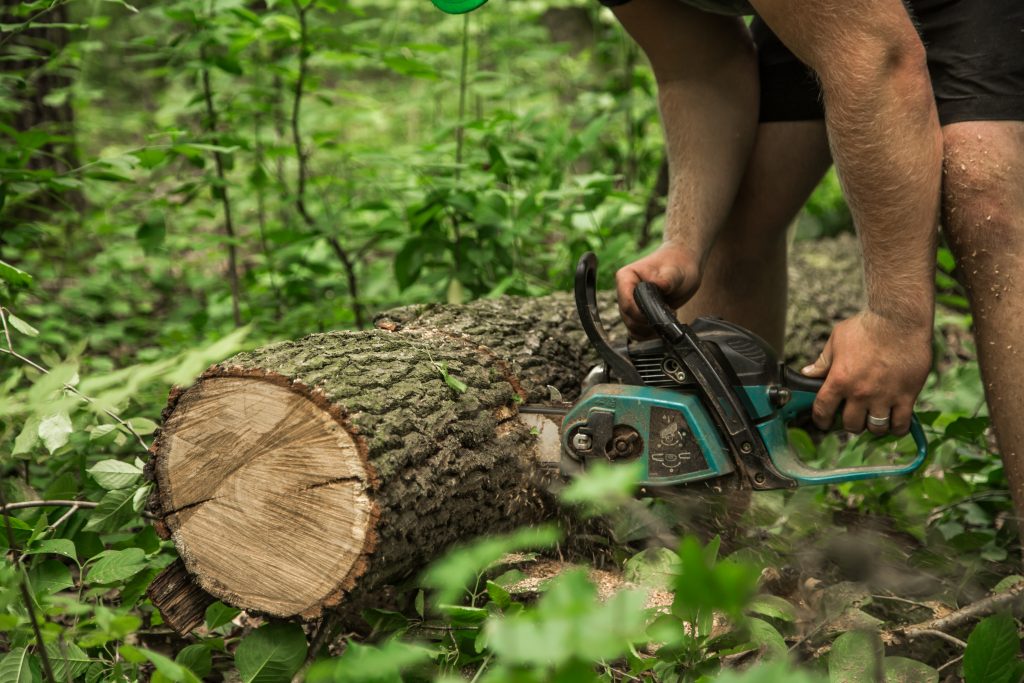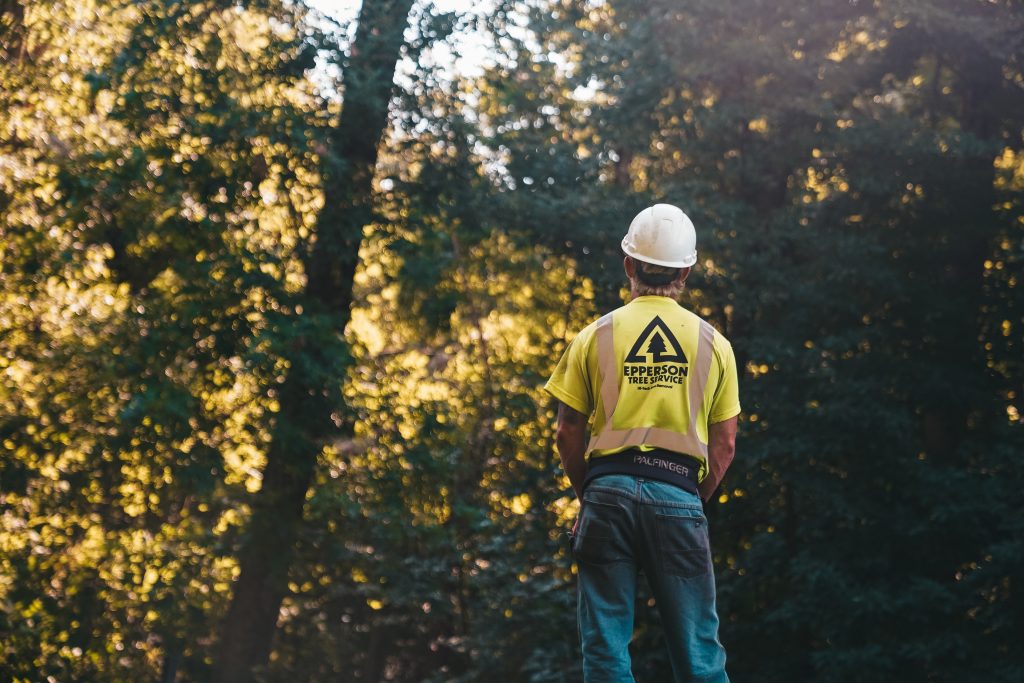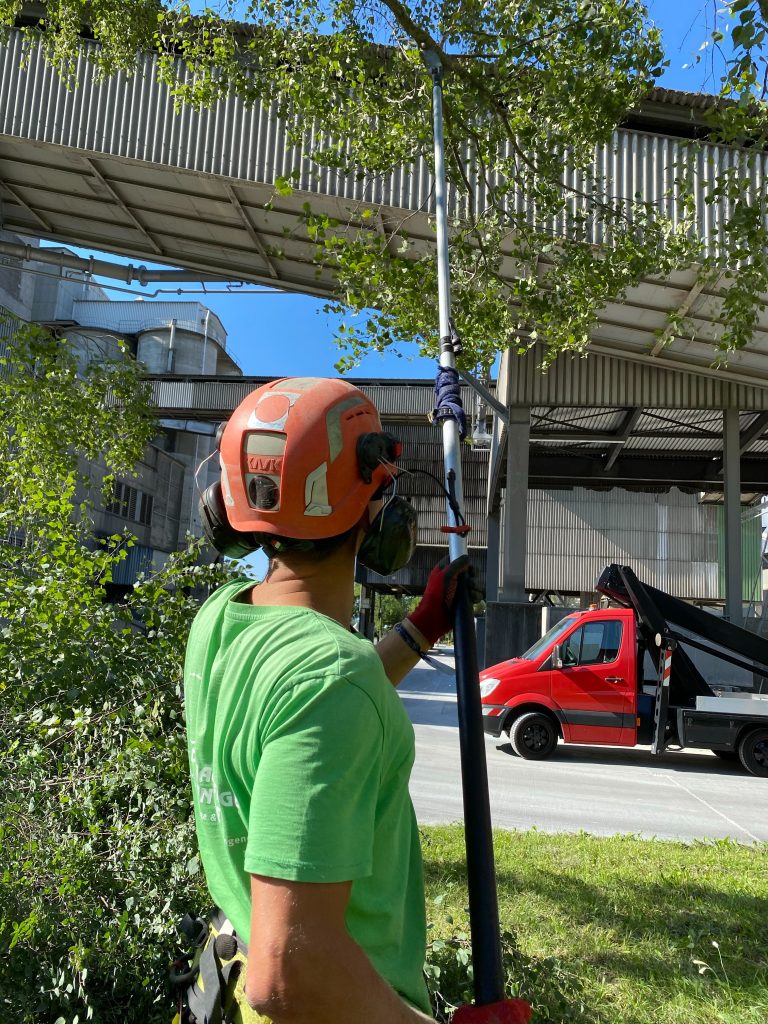THE BASICS OF STUMP GRINDING AND REMOVAL
THE BASICS OF STUMP GRINDING AND REMOVAL
Stump grinding and removal are essential steps in tree care and property maintenance that address the remnants of trees after they have been cut down. These processes go beyond tree removal by eliminating the stumps left behind, which can have various implications for safety, aesthetics, and the overall health of your landscape. Here’s an explanation of why stump grinding and removal are crucial aspects of tree care and property maintenance:

1. Safety and Accessibility:
• Tree stumps left in your landscape pose potential safety hazards. They can be tripping hazards, especially if they’re not easily visible, which can lead to accidents for people walking or running on your property. Stump removal eliminates this risk, making your outdoor space safer for residents, visitors, and even wildlife.
2. Aesthetic Appeal:
• Stumps can be eyesores in an otherwise well-maintained landscape. Removing them improves the overall visual appeal of your property, enhancing its aesthetics and creating a more polished appearance.
This is especially important if you plan to sell or rent the property, as curb appeal plays a significant role in attracting potential buyers or tenants.
3. Regrowth Prevention:
• If a tree stump is left in the ground, there’s a possibility of regrowth. Shoots and sprouts can emerge from the remaining root system, leading to the re-establishment of the tree. Stump removal not only prevents this regrowth but also eliminates the potential for future maintenance challenges.
4. Land Use and Landscaping:
• Stump-free land offers greater flexibility for landscaping projects. Removing stumps clears the way for planting new trees, shrubs, flowers, or other features, allowing you to design and utilize your outdoor space more effectively.
5. Disease Prevention:
• Tree stumps can harbor diseases and pests that can spread to other nearby plants. Removing the stump reduces the risk of diseases and pests affecting the health of other trees and vegetation in your landscape.
6. Property Value:
• The appearance of your property significantly impacts its value. Stump removal contributes to an improved appearance, which in turn can enhance your property’s value and make it more appealing to potential buyers or tenants.
7. Space Optimization:
– Removing stumps opens up valuable space that can be used for various purposes, such as creating recreational areas, installing outdoor structures, or expanding your garden.
8. Preventing Root Decay:
– Over time, the decaying root system of a stump can attract insects and fungi that may spread to other healthy plants. Stump removal eliminates this potential source of root decay.
9. Eco-Friendly Approach:
– Stump grinding often produces wood chips that can be repurposed as mulch or compost, promoting sustainable landscaping practices.
In summary, stump grinding and removal are essential steps in tree care and property maintenance that go beyond the initial tree removal process. They address safety concerns, enhance property aesthetics, prevent regrowth, and create a more functional and visually appealing landscape. By investing in stump removal, you not only improve the immediate appearance of your property but also contribute to its long-term health and value.
A tree stump is the portion of a tree trunk that remains in the ground after a tree has been cut down or removed. It is the base of the tree that’s left behind, usually extending a certain distance above the ground level. Stumps can vary in size and appearance depending on the tree species, the method of tree removal, and the depth to which the tree was cut.
Stumps are often left after tree removal due to several reasons, including the challenges associated with complete removal and the potential impact they can have on the landscape:

1. Removal Complexity:
• Completely removing a tree stump can be a labor-intensive and technically demanding task. The root system of a tree can extend far and deep into the ground, making it difficult to extract the entire stump without damaging surrounding structures or the landscape.
2. Cost Considerations:
• The process of fully removing a tree stump involves specialized equipment and expertise, which can lead to higher costs compared to simply cutting the tree down. As a result, property owners sometimes opt to leave the stump as a cost-saving measure.
3. Regrowth Potential:
• Stumps left behind have the potential to regrow through the shoots and sprouts that emerge from the remaining root system. This regrowth can lead to new tree growth, which might not be desirable, especially if the tree was removed for specific reasons such as disease or safety concerns.
4. Landscape Impact:
• Tree stumps left in the landscape can have several potential impacts:
• Aesthetic Disruption: Stumps can be unsightly and disrupt the overall appearance of the landscape, detracting from the visual appeal of the property.
• Obstruction: Stumps can get in the way of mowing, landscaping, or other outdoor activities, limiting the use of your outdoor space.
• Tripping Hazards: Stumps that are not easily visible can become tripping hazards, posing safety risks to people and pets.
5. Decay and Pest Concerns:
• Over time, the stump and its remaining root system can decay. Decaying stumps attract insects, fungi, and other pests, which can spread to nearby plants and affect the overall health of the landscape.
6. Land Use Limitations:
• Stumps left in the ground restrict the potential use of the land for other purposes, such as planting new trees, installing structures, or creating new landscaping features.
7. Incomplete Transformation:
– Leaving a stump after tree removal might leave a property with a sense of unfinished transformation, hindering efforts to create a well-maintained and cohesive landscape.
In summary, tree stumps are the remaining portions of tree trunks left in the ground after tree removal. Stumps are often left due to challenges in complete removal, cost considerations, and the potential impacts they can have on the landscape. However, it’s important to consider the potential drawbacks of leaving stumps, including aesthetic disruption, regrowth potential, and safety concerns. Property owners should weigh these factors and consider stump grinding or removal as part of their landscape maintenance and improvement plans.
Removing tree stumps is important for a variety of reasons, encompassing safety, aesthetics, and the prevention of potential regrowth. Addressing these factors is crucial for maintaining a visually appealing, functional, and hazard-free landscape. Here’s an explanation of why it’s essential to remove tree stumps:
1. Safety Concerns:
• Tripping Hazards: Stumps left in the ground can pose tripping hazards, especially if they’re not easily visible. This can lead to accidents for both pedestrians and those engaged in outdoor activities on the property.
• Machinery Hazards: Stumps can be hazardous to lawnmowers, vehicles, and other machinery that come into contact with them, potentially causing damage or accidents.
2. Aesthetic Considerations:
• Visual Appeal: Stumps are often unsightly and can disrupt the overall aesthetic of your landscape. Removing them enhances the visual appeal of your property, creating a more polished and well-maintained appearance.
• Landscape Cohesion: Stump-free landscapes offer a more cohesive and harmonious look, allowing other landscaping elements to shine without the distraction of stumps.
3. Prevention of Regrowth:
• Shoots and Sprouts: Tree stumps left in the ground can lead to regrowth through shoots and sprouts emerging from the remaining root system. This regrowth can result in new trees or shrubs that might not align with your landscape design goals.
4. Land Use Flexibility:
• Enhanced Landscaping: Removing stumps opens up space for landscaping projects, allowing you to design and utilize your outdoor area more effectively. You can plant new trees, create garden beds, or install structures without the hindrance of stumps.
5. Disease and Pest Prevention:
• Disease Spread: Decaying stumps can attract diseases and pests that may spread to other nearby plants, potentially affecting the health of your landscape.
• Insect Attraction: Decaying wood is attractive to insects, which could find their way into your property, potentially leading to infestations.
6. Future Maintenance Challenges:
• Complications in Lawn Care: Stumps can make lawn maintenance difficult, obstructing mowing and trimming efforts. This can lead to uneven grass growth and an unkempt appearance.
7. Property Value and Curb Appeal:
– Curb Appeal: Stump-free landscapes contribute to a more attractive and inviting curb appeal, which positively impacts your property’s overall value and desirability. – Potential Buyers: For those looking to sell their property, a well-maintained landscape without unsightly stumps can make a more favorable impression on potential buyers.
8. Environmental Considerations:
– Rotting Wood: Decaying stumps can release carbon dioxide into the atmosphere as they break down. Removing stumps reduces this source of carbon emissions.
In summary, removing tree stumps is important for ensuring safety, enhancing the appearance of your property, preventing regrowth, and maintaining a functional landscape. By addressing these aspects, property owners can create a safer and more attractive outdoor space, reduce potential maintenance issues, and contribute to the overall health and beauty of their landscape.
How Stump Grinding Works
Stump grinding is a mechanical process used to remove tree stumps from the ground. It involves using specialized equipment called a stump grinder to chip away the stump and its root system until it is ground down below the surface level. Stump grinding is an effective method to eliminate stumps while minimizing impact on the surrounding landscape. Here’s how stump grinding works:
1. Equipment Setup:
• A stump grinder is a heavy-duty machine equipped with a spinning cutting wheel or blade. The size and power of the grinder depend on the size and hardness of the stump.
2. Safety Precautions:
• Before starting the process, the operator wears appropriate protective gear, including safety goggles, gloves, and hearing protection. The area around the stump is cleared of debris and obstacles.
3. Stump Positioning:
• The stump grinder is maneuvered into position near the stump. The operator positions the grinder to ensure safe and efficient grinding.
4. Initial Grinding Pass:
• The grinding process begins with the operator lowering the cutting wheel onto the stump. The wheel rotates rapidly and chips away at the stump material.
5. Gradual Grinding:
• The operator gradually moves the cutting wheel back and forth across the stump, grinding it down layer by layer. The grinding depth can be adjusted based on the depth of the stump and the desired outcome.
6. Root System Grinding:
• As the stump is ground down, the operator also grinds the exposed portions of the root system. This is crucial for preventing potential regrowth and eliminating any remaining root material.
7. Wood Chips and Mulch:
• The grinding process generates wood chips and mulch-like material, which are typically left on the ground as they can serve as natural mulch. These wood chips can be raked into the surrounding soil or used for other landscaping purposes.
8. Grinding Depth:
• Depending on the situation and the intended use of the area, the operator can adjust the grinding depth to remove the stump to a specific level below the ground.
9. Leveling and Cleanup:
• Once the stump is ground down to the desired level, the operator stops the grinder. Any remaining wood chips and debris are cleared away, and the area is leveled if needed.
10. Disposal or Reuse of Wood Chips:
– The resulting wood chips and mulch can be used as natural ground cover or added to compost piles. Some property owners choose to have the wood chips removed, while others use them as a landscaping resource.
Stump grinding is an efficient and practical method for removing stumps from the landscape. It eliminates the majority of the stump, including the root system, preventing regrowth and allowing for easier landscaping and future planting in the area. While stump grinding may leave behind some wood chips, these can be integrated into the soil, providing nutrient-rich organic material. Hiring a professional stump grinding service ensures proper equipment use, safety, and effective stump removal.
About Murray, Utah
Murray is a city situated on the Wasatch Front in the core of Salt Lake Valley in the U.S. state of Utah. Named for territorial governor Eli Murray, it is the state's fourteenth largest city. According to the 2020 census, Murray had a population of 50,637. Murray shares borders with Taylorsville, Holladay, South Salt Lake and West Jordan, Utah. Once teeming with heavy industry, Murray's industrial sector now has little trace and has been replaced by major mercantile sectors. Known for its central location in Salt Lake County, Murray has been called the Hub of Salt Lake County. Unlike most of its neighboring communities, Murray operates its own police, fire, power, water, library, and parks and recreation departments and has its own school district. While maintaining many of its own services, Murray has one of the lowest city tax rates in the state.
Neighborhoods in Murray, Utah
Murray Oakes, Grant Park, Southwood Park, Murray Park, Murray Park Restrooms, Willow Pond Park, Neighborhood Veterinary Care
Things To Do in Murray, Utah
Bus Stops in Murray, Utah to Truco Services, Inc.
Bus Stop in Murray Central Station (Bay C) Murray, Utah to Truco Services, Inc.
Bus Stop in State St @ 4801 S Murray, Utah to Truco Services, Inc.
Bus Stop in Murray North Station Murray, Utah to Truco Services, Inc.
Bus Stop in State St @ 4949 S Murray, Utah to Truco Services, Inc.
Bus Stop in Murray Central Frontrunner/Trax Station Murray, Utah to Truco Services, Inc.
Bus Stop in Murray Blvd / Vine St (SB) Murray, Utah to Truco Services, Inc.
Bus Stop in State St @ 3925 S Murray, Utah to Truco Services, Inc.
Bus Stop in State St @ 4824 S Murray, Utah to Truco Services, Inc.
Bus Stop in State St @ 5223 S Murray, Utah to Truco Services, Inc.
Bus Stop in Murray Blvd / Allendale Dr (NB) Murray, Utah to Truco Services, Inc.
Bus Stop in Murray Blvd @ 5039 S Murray, Utah to Truco Services, Inc.
Bus Stop in State St @ 4721 S Murray, Utah to Truco Services, Inc.
Driving Directions in Murray, Utah to Truco Services, Inc.
Driving Directions from Woodruff Tree Trimming and Removal to 4640 Commerce Dr, Murray, UT 84107, USA
Driving Directions from Reliable Tree Care to 4640 Commerce Dr, Murray, UT 84107, USA
Driving Directions from Tree Pro-Tech to 4640 Commerce Dr, Murray, UT 84107, USA
Driving Directions from Prestige Tree And Landscape to 4640 Commerce Dr, Murray, UT 84107, USA
Driving Directions from Excellence Tree & Landscape to 4640 Commerce Dr, Murray, UT 84107, USA
Driving Directions from Amen Trees to 4640 Commerce Dr, Murray, UT 84107, USA
Driving Directions from Tim's Tree Care to 4640 Commerce Dr, Murray, UT 84107, USA
Driving Directions from Jordan Tree Service - Murray to 4640 Commerce Dr, Murray, UT 84107, USA
Driving Directions from Arbor Works to 4640 Commerce Dr, Murray, UT 84107, USA
Driving Directions from Diamond Tree Experts to 4640 Commerce Dr, Murray, UT 84107, USA
Driving Directions from Green Tree Arborist to 4640 Commerce Dr, Murray, UT 84107, USA
Driving Directions from TruCo Services to 4640 Commerce Dr, Murray, UT 84107, USA
Reviews for Truco Services, Inc. Murray, Utah
Emily Abercrombie
We had a great experience with TruCo! They were well priced, responsive and prompt. Michael was a pleasure to work with and gave us advice on which plants to put in where we took out our ugly old shrubs. I would highly recommend this company!!!
Michelle Turpin
TruCo Services gets 5 stars from us for customer service. We experienced a few issues with their services this last year and Rob Eccles in senior management, stepped in and immediately handled our issues. He was very committed to making sure they understood our expectations and would execute to make us happy.
Siobhan Billingsley
I work for a property management company and have the pleasure of working with Rob at a community in Sandy. He has been incredible to work with and always responds in a timely manner. He knows all the homeowners by name and address and is aware of all the "problem" areas when it comes to sprinklers. I never have to worry about following up with him because he always reaches out to provide me with an update. If you're looking to work with someone who takes pride in their job, is professional, and can solve the worst landscaping problems thrown your way, Rob is your guy. Thank you, Rob for all you do!
Jaime S.
We have used Truco at 2 of the complexes we manage, they have been great to work with. Good quality service, outstanding customer service with good communication. That's hard to find these days. I highly recommend them. Travis has been awesome to work with.
Jerusha Smart
We use TruCo for a majority of our properties and our home. While other landscaping companies we use come and go for various reasons like cost, communication issues, work performance, etc., TruCo is always consistent in price and work. Also, Rob is the best.

